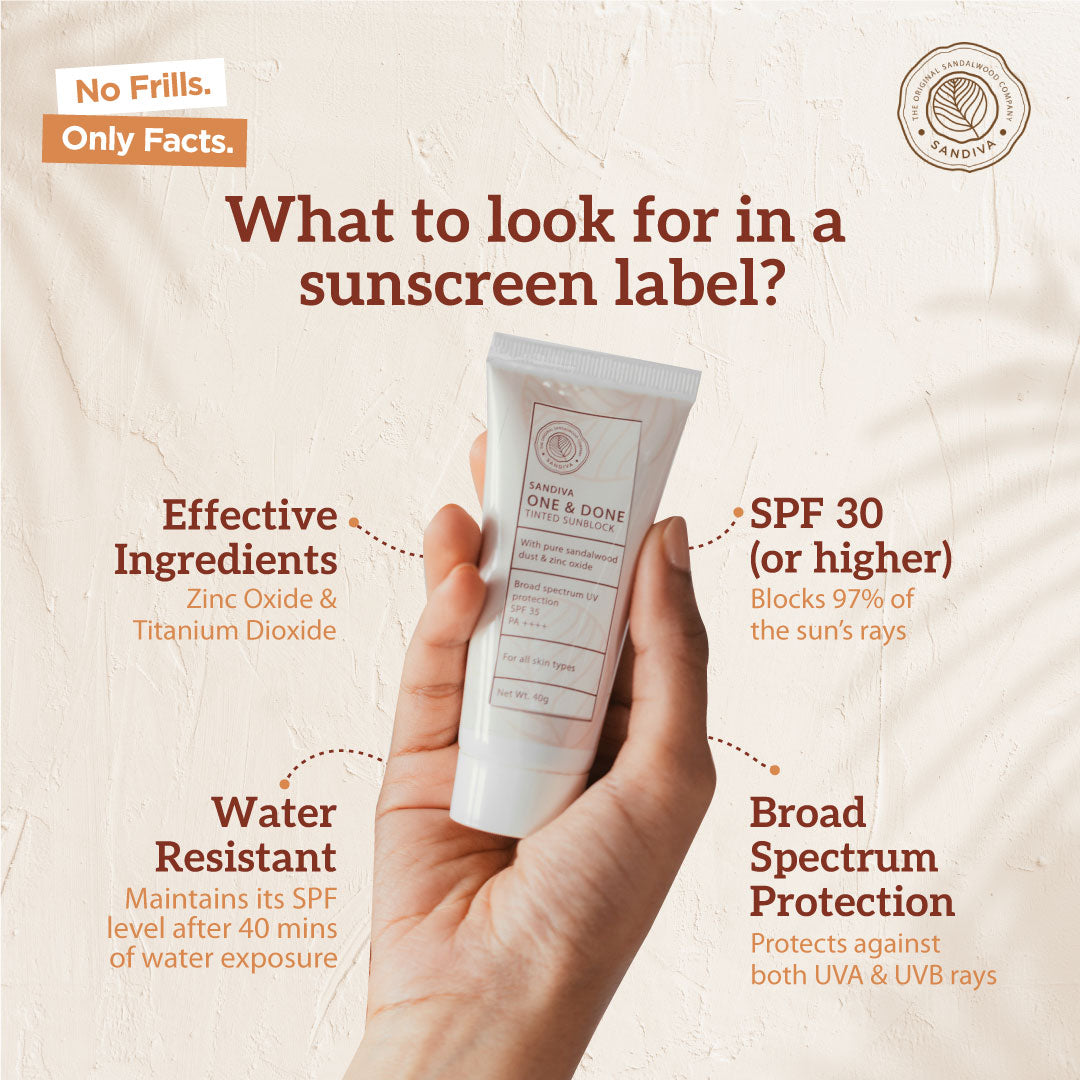Free shipping on all orders above Rs. 450
Tags
Recent Post
Archive
- July 2024
- April 2024
- March 2024

What Should You Look For In A Sunscreen Label?
- By Sandiva Skincare
- 29 February, 2024
Sunscreen labels are becoming akin to the labels on snacks. Often they are written to confuse!
But here is a simple 7 point guide that will empower you to understand the product and hence make the right product choices.
1. Broad Spectrum Protection
Look for sunscreens labelled as "broad-spectrum", meaning they protect against both UVA and UVB rays. UVA rays penetrate the deepest layer of the skin (dermis) causing cell damage, contributing to premature ageing and skin cancer. UVB rays, on the other hand, damage the outer layer of the skin causing sunburn. Ensuring your sunscreen guards against both types of rays provides comprehensive protection against the sun’s harmful effects of UV rays and prevents sun damage.
2. Sun Protection Factor (SPF)
The SPF on a sunscreen label indicates its ability to protect against UVB rays, the primary cause of sunburn. SPF 30 is considered to be a sufficient and good level of sun protection for daily use. It means that the sunscreen filters out approximately 97% of UVB rays as opposed to SPF 50 which filters out 98%, but no sunscreen can block 100% of the sun’s rays.
3. PA+ Ratings
PA stands for Protection Grade of UVA rays. It is a rating system indicating the level of UVA protection a sunscreen provides. The more plus signs (+) following the PA, the higher the level of UVA protection. PA++++ indicates the highest protection for the skin from UVA rays.
4. Water-Resistant
If you indulge in outdoor activities that involve water or sweat such as swimming or running, opt for a sunscreen labelled as water-resistant. Keep in mind that no sunscreen is entirely waterproof, and reapplication after every 2 hours is necessary after swimming or heavy perspiration. Water resistance is typically labelled as either 40 or 80 minutes, indicating the duration of effectiveness while in water.
5. Active Ingredients
Sunscreens are formulated with active ingredients to provide UV protection. Common components include zinc oxide, titanium dioxide, avobenzone, octocrylene, and octinoxate. Zinc oxide and titanium dioxide are physical blockers that are used in physical or mineral sunscreens. They sit on top of the skin reflecting sunlight. Chemical filters like avobenzone and octinoxate are used in chemical sunscreens that absorb UV rays and release them from the body in the form of heat. To know more about what are the unsafe chemicals and safe minerals in sunscreens read our blog post What Are the Good And Bad Sunscreen Ingredients?
6. Non-Comedogenic
“Non-comedogenic” refers to skincare or cosmetic products formulated to not clog pores or promote the formation of acne, blackheads and whiteheads. They are often for individuals with oily or acne-prone skin to minimise the risk of breakouts and maintain clear, healthy skin. Thus, if you have skin that’s prone to acne, opt for a sunscreen that’s non-comedogenic.
7. Hypoallergenic
"Hypoallergenic" is a term used to describe products or substances that are less likely to cause an allergic reaction in individuals. They are formulated to minimise the risk of triggering allergic responses and are suited for those with sensitive skin. Opt for a sunscreen that has “hypoallergenic” on the label if you have sensitive skin and are prone to allergic reactions.
So, the next time you shop for sunscreen, navigate the labels confidently and step out into the sun with the assurance that your skin is well-protected.
Sandiva’s One and Done Tinted Sunblock is a light-weight physical sunscreen that provides heavy-duty protection from UVA and UVB rays. With SPF 35+, PA++++, it forms a protective barrier against sun damage. Packed with the goodness of sandalwood it helps calm inflammation caused due to sun exposure. It is also non-comedogenic and hypoallergenic, making it suitable for all skin types.
It is available in 4 different tints to suit Indian skin tones, specially formulated to prevent white cast, seamlessly blending into your skin to give you a light-makeup look!
- Manufactured by
-
T.S.R AND COMPANY MADRAS
Old No.102 New No.2/2,
Mount Poonamallee Road, Ramapuram,
Chennai, Tamil Nadu, 600089 - Sales fulfilled by
- Tiesar Personal Care Pvt Ltd






